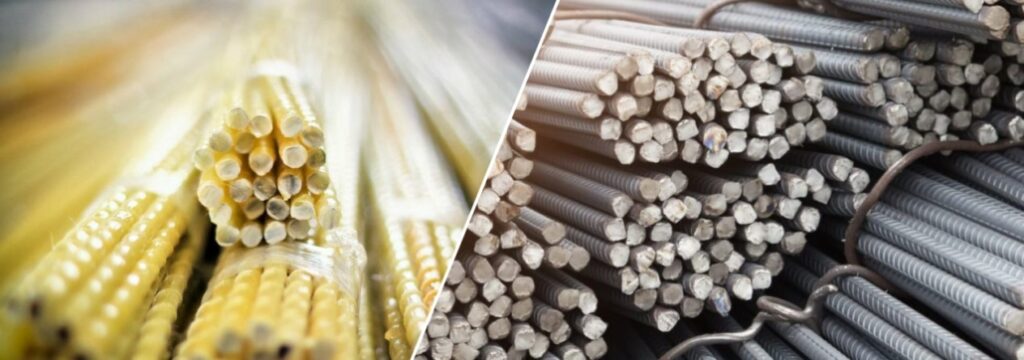En ce qui concerne les barres d'armature utilisées universellement dans les secteurs industriel et civil, vous vous interrogez peut-être sur les différences entre les barres d'armature en PRF et leurs homologues en acier. Malgré une tendance évidente à l'adoption des barres d'armature en PRF dans divers secteurs, certaines entreprises restent sceptiques et multiplient les recherches sur les perspectives, les caractéristiques et les performances des PRF par rapport à celles de l'acier.
Contenu
Barres d'armature en acier et leurs propriétés
L'acier est reconnu pour ses excellentes qualités, utilisées dans de nombreux secteurs industriels. Son inconvénient est sa sensibilité à l'humidité et, par conséquent, à la corrosion. Toutes sortes de réactions chimiques, comme l'oxydation, finissent par affecter négativement ses propriétés. Par conséquent, l'utilisation des barres d'armature en acier est limitée dans certains secteurs.
L'avantage d'un faible coût initial est compensé par des coûts de transport et d'installation sur site plus élevés, compte tenu de son poids important. À long terme, les barres d'armature en acier corrodées nécessitent un entretien coûteux et entraînent une augmentation de la charge de traction. structures en béton.
Barres d'armature en PRF et leurs propriétés
Le PRF, ou polymère renforcé de fibres, remplace l'acier dans de nombreux secteurs. Résistant à la corrosion et à divers processus et réactions chimiques, le PRF est devenu le matériau privilégié pour les applications marines et en plein air.
Divers additifs utilisés pour améliorer certaines propriétés peuvent augmenter la capacité de traction globale et l'endurance des produits FRP, y compris les barres d'armature, les silos, les réservoirs, etc. La résistance à la traction des barres d'armature en fibre est 20% supérieure à celle d'une barre d'acier.
La force de liaison du matériau du renfort en fibres est considérablement plus forte que celle de l'acier ; cela explique une meilleure endurance opérationnelle Barres d'armature en PRFV.
La fabrication personnalisable permet d'adapter les résines utilisées pour la production de barres d'armature FRP afin de répondre aux exigences spécifiques de chaque niche, par exemple en améliorant la résistance à l'abrasion ou à la corrosion.
Barres d'armature en PRF vs. Barres d'armature en acier
Un autre avantage crucial du PRFV par rapport à l'acier est sa légèreté. Les barres d'armature en PRFV pèsent seulement ¼ de celles en acier de taille équivalente. Par conséquent, l'utilisation de barres d'armature en PRFV réduit les coûts d'expédition et d'installation.
Un autre facteur important est la résistance aux chocs. Sous une charge de travail importante, le PRF ne se déforme pas de manière permanente, car la matrice polymère renforcée par des résines est capable de répartir la charge d'impact, préservant ainsi la surface des dommages. Dans des conditions similaires, notamment à basse température, les produits en acier peuvent se déformer.
Malgré une gamme d'applications tout aussi large, le PRF diffère de l'acier en termes de conductivité électrique et thermique. L'acier est un bon conducteur d'électricité et de chaleur, tandis que le PRF présente une conductivité thermique plus faible et une conductivité électrique nulle. Dans un environnement soumis à des fluctuations thermiques, le PRF présente des propriétés plus stables que l'acier, dont les caractéristiques peuvent varier sous l'effet de la température extérieure.
| Propriétés | Barres d'armature en PRF | Barres d'armature en acier |
| Poids | ¼ du poids de l'acier | 10 mm, 0,617 kg/m (ou 0,188 kg/pi) |
| Force | 206,5 mpa | 248,2 mpa |
| conductivité électrique | Non conducteur | Conducteur |
| Conductivité thermique | Faible | Haut |
| Résistance à la corrosion | Élevé (non affecté par l'eau) | Faible (sans traitement de galvanisation coûteux, les barres d'acier sont sujettes à l'oxydation) |
| Résistance aux charges lourdes | Aucune déformation permanente | Peut être déformé de façon permanente |
| Frais | Réduction des coûts de fabrication, des coûts de maintenance et des frais de transport (liés à la légèreté) | Des coûts de matériaux inférieurs mais des coûts globaux de production, de transport, d'installation et de maintenance technique plus élevés |
Industriel et commercial applications des barres d'armature en PRF Cela comprend des tunnels blindés, des ponts, des aéroports, des autoroutes, des stations d'eau, des installations de conservation des déchets, des usines de traitement des eaux usées et des produits chimiques, ainsi que toutes sortes de projets côtiers.
Réflexions finales
Lorsqu'il s'agit de choisir entre des barres d'armature en PRF et des barres d'armature en acier, le PRF l'emporte dans de nombreuses applications grâce à ses performances supérieures en termes de résistance thermique, de corrosion et de résistance chimique. Si l'on ajoute à cela un poids bien plus léger qui facilite le transport grâce à une réduction supplémentaire des coûts, le choix semble évident. Pourtant, les barres d'armature en acier sont irremplaçables par rapport au PRF dans les applications industrielles exigeant une conductivité électrique. Hormis les applications hautement spécialisées, les barres d'armature en PRFV sont considérées à juste titre comme une alternative économique aux barres d'armature en acier.
Pour plus d'informations sur Équipement de barres d'armature en PRFV, machines à barres d'armature FRP et autres solutions innovantes, visitez Site Web de Composite-Tech aujourd'hui et découvrez comment nous façonnons l'avenir de la construction.
Apprendre encore plus:
- Treillis en PRFV aux États-Unis
- Treillis en PRFV versus treillis métallique en acier pour dalles sur terre-plein et sols industriels
- Pourquoi les clients du monde entier choisissent Composite-Tech comme fournisseur d'équipements le plus fiable pour la production de barres d'armature en PRFV
- Pourquoi la production de barres d'armature en PRFV est-elle rentable ? Calcul complet des coûts
- Fibre GFRP pour béton : une solution révolutionnaire pour le renforcement du béton
- Comprendre les barres d'armature en PRF et en PRFV

